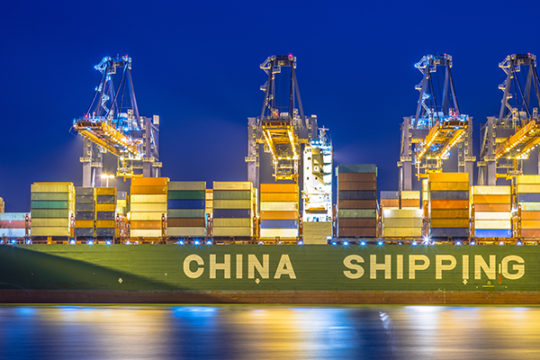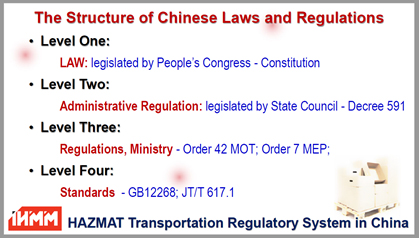
One of the most fascinating presentations at the latest Dangerous Goods Symposium was from Terry Guo, CDGP, DGSA, Regulatory Specialist and China Representative with IHMM. His presentation on “Hazardous Materials Transport Requirements in China” was an excellent primer on a very complex subject.
You can download his full presentation here, but we also spoke with Guo to get more background and insight for people who couldn’t join us at the Symposium. Here are a few critical points to consider for any manufacturer or shipper with an eye on the Chinese market.
One: Chinese Dangerous Goods Transport requirements are generally based on UN Regulations, but are usually more restrictive
“In general, Chinese regulations are more restrictive than international regulations,” says Guo. “The industrial environment is different, and they believe they need a higher standards. They don’t want to lose control of the process.”
Part of this distinction traces to China’s industrial history—one that’s very different from that of the United States, Canada or most European countries.
Guo explains, “Historically, Chinese industry—both their infrastructure and their regulatory culture—has been based on what they learned from the Soviet Union in the 1950s. They didn’t begin to adapt to Western practices until about 40 years ago. The older structure was friendly to state-run enterprises, but not so friendly to private enterprise since there were no private ones back then. Now, there’s still a lag in being more friendly to private enterprise.”
Two: Modes matter
Shippers in North America and Europe will be relieved to know that, as long as their China-bound shipment is in international air space or on an ocean vessel, the familiar IATA and IMDG regulations will apply. Once those shipments reach a Chinese port, however, the governing regulations may start to seem, well, foreign.
“The domestic requirements for road, inland waterways and rail are more constrained,” says Guo. “U.S. and European manufacturers often have a lot of confusion with Chinese domestic regulations. Their knowledge of the 49 CFR and the ADR will not help much, since there are some parts that are so different.”
He estimates that 70% of Chinese regulations are similar to international rules, but the rest are not. For example, new road regulations mainly are adopted from the 2015 edition of the ADR—but only seven parts, not all nine. Why? Because Part 6 (packaging) and Part 9 (vehicle requirements) are not the responsibility of the Chinese Ministry of Transport but are governed by other ministries using more local requirements.
Three: You’ll deal with multiple regulatory levels and standards
Transporting hazmat within China—whether you’re delivering goods manufactured elsewhere or transporting goods from Chinese facilities to port—means dealing with multiple levels of regulation and standards.
Guo’s presentation described a four-level structure of laws and regulations:
- Law, legislated by the People’s Congress
- Administrative Regulation
- Ministry Regulations
- Standards

The standards themselves break down into four layers:
- National Standards
- Ministerial Standards
- Industrial Standards
- Enterprise Standards

These layers can make compliance complex and challenging, particularly with regards to packaging. Guo admits, “You have to follow the local transportation rules and comply with warehousing issues. Pay more attention to road transport and you’ll have a better time of it.”
Four: Progress is being made
For sure, shipping Dangerous Goods in China is easier than it was a few years ago.
Guo points to the Excepted Quantity and Limited Quantity provisions, which were only adopted in China last year. “There were a lot of complaints from consumer packaged goods companies shipping products such as fragrances. They had to hire specialized trucks designed for the chemical industry. That’s why Alibaba and other e-commerce shippers applied to the Ministry to adopt Excepted Quantity and Limited Quantity.”
While the availability of EQ and LQ make shipping certain Dangerous Goods easier, Guo points out that “there is a concession period when the rules are still more restrictive. That’s what we are facing now. Compared to the U.S, you still need a more expensive box.”
Why not simply adopt the same rules as the international community? “They’re afraid people will think EQ and LQ mean ‘no restriction, common cargo’ and just use a cheap ordinary box.”
Five: Don’t go it alone
English will serve you well if you’re shipping hazmat in North America or Europe, but Guo recommends you enlist some help with Chinese if you’re shipping into (or out of) China.
He says, “The requirements for MSDS form of imported hazmat goods now must be in Chinese language as well as English, so regional authorities can have a more accurate understanding of the materials. They don’t want to overlook something.”
If your organization lacks experience with Chinese Dangerous Goods requirements, Guo recommends working with a China-based consulting company such as REACH24H. He also points out the advantages of having employees who can read and speak Chinese.
Or, he says, just to get started, “You can always use Google translate on the Ministry of Transport website.”
Make sure your shipments are safe and in complete compliance with a full line of solutions from Labelmaster—a full-service provider of goods and services for hazardous materials and Dangerous Goods professionals, shippers, transport operators and EH&S providers.



Hello,
I am running into issues shipping fragrance out of China. Our shipments qualify as ID 8000 Class 9 Dangerous Goods everywhere BUT China. My freight forwarders are saying that ID 8000 Class 9 products still require UN boxes in China and are not exempt from UN boxes like everywhere else. Anyone have any thoughts on whether this is legitimate or not?
Hello Anthony,
That is a tricky one, please give our regulatory department a phone call and we will research the issue to clarify the rules. +1 773-478-0900.
Thanks!
Labelmaster
Hello, What is the certification needed to ship via ground in China? Basically, what is the equivalent of the CFR49 for China?
We would like to get someone certified to ship out of China.
Hi Gerado, please give our regulatory line a call to help clarify your situation, they can be reached at 1-800-621-5808.
Hello. It appears the none of the major carriers are shipping DG, via air, to Mainland China. UPS and FedEx wouldn’t even allow me to finish their AWB process when trying to ship a small amount of Class 8, PGIII material (epoxy) and DHL just returned the package stating the reason as, “The People’s Republic of China is not accepting any fully regulated DG via IATA/Air”. I can’t find anything online to substantiate a full ban on incoming, regulated DG and I didn’t get any warning via the DGIS system. Is China really not accepting ANY DG via air? I know they banned the import of lithium batteries via air, but all DG? Thanks.
Jason B. I am having the same problem!!! My customer in China said they can’t find a reason why it is being blocked on their side. At first FedEx and DHL said they could take it and then they said no. FedEx is claiming we need approval from the Chinese government now. And DHL said ” Thank you for reaching out to us, we would be happy to prepare this shipment. However, at this time DHL is not transporting dangerous goods to China.”
I have shipped many times before with FedEx going by Air Freight using a 023 airway bill. Now it is a no go and I am having a hard time contacting the Ministry of Commerce People’s Republic of China.
Hi,
I am trying to ship some Loctite (UN3082, Class 9 materials) to my supplier in China. I have the SDS in Mandarin but the supplier ask me to apply the DG label in Mandarin. I contacted the manufacturer Henkel and hasn’t received their response. Do you have any good suggestion?
Thank you,
Jennifer
HI There,
I have a client that wishes to ship Class 1.4G UN#0336, Colour Smoke Flanges.
the cargo is originating from Shanghai but our local offices there mention they cannot handle the product due to the Class,
Is there any other port in China we’re able to use to get this cargo to South Africa?
Hi Mani,
Sorry, that is outside our scope, Ypu could consult the export agency int he PRC to find a suitable port.
Hi, I’m considering importing essential oil from China to the US to sell as FBA on Amazon. However, The issue is being Hazmat, Amazon require that we comply on labeling and handling the packaging with the flammable sign. When I informed the supplier of the requirement, they said that if they put the sticker on, the shipment will be rejected by shipping company and customs (based on their experience. But without that hazardous label on, Amazon will reject the shipment as well. Now this issue is a pressing issue for us. Would appreciate your advice and recommendation.
Dear Ann, US law requires that if the material is classified as hazardous, that it be correctly marked and labeled. So there really isn’t any leeway.
Hope that helps!
Hello. I am working with a client who trying to ship sunscreen product to China. They are being told by the authorities at the port that there is a new regulations effective 2/22 that they must include 100% components on the SDS. My client has only included the ingredients contributing to the hazard and they do not want to disclose 100% of the formulation. Is there an amendment to the current China regulation that states 100% of the product formulation should be stated on the SDS?